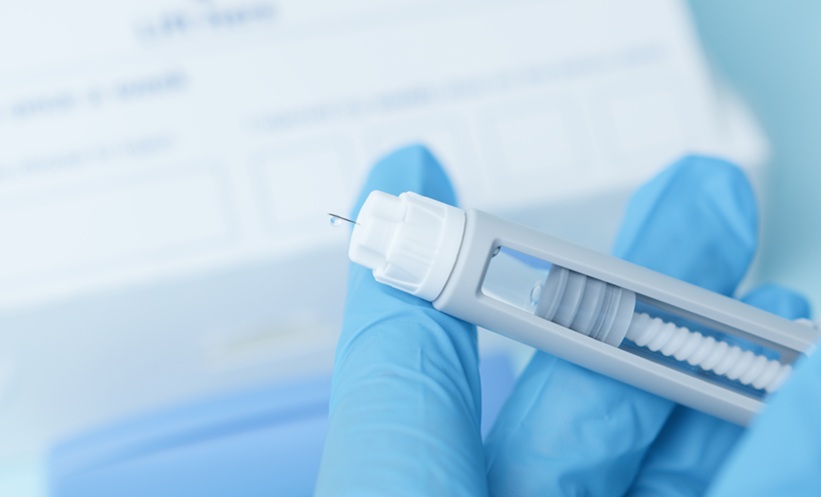Abstract
Acne vulgaris is one of the most common skin diseases in the world. There are many factors involved in its pathogenesis. The dermatosis is characterised by seborrhoea and the formation of comedones, pustules, and papules and is very unpleasant for patients. Recent data have shown that there may be a connection between acne, diet, and dietary supplements. Researchers have found that milk and dairy products, high glycaemic load, and a diet low in omega-3 fatty acids can aggravate acne. On the other hand, there is also a hypothesis that oral supplementation can be beneficial. Supplements cited as beneficial are products containing omega-3 fatty acids, antioxidants, and probiotics. However, there are still many inaccuracies in this area of dermatology and further research is needed before any recommendations can be made.
INTRODUCTION
Acne vulgaris is a common skin disease occurring most often during puberty. Its pathogenesis has multiple factors and is very complex. The dermatosis is characterised by seborrhoea and the formation of comedones, pustules, and papules in areas rich in sebaceous glands.1,2 The variety of clinical acne is very wide. Patients may present with only a few blackheads or be afflicted with general skin involvement that consists of pustular deep lesions, abscesses, scarring and, though occurring rarely, can also involve the joints as in the case of acne fulminans. There are a few forms of acne vulgaris: acne comedonica, which is dominated by open and closed comedones; acne papulopustulosa, which is dominated by the inflammatory process; and acne conglobata, which is the most severe form of acne and is characterised by abscesses, fistulas, and scars.3
Acne vulgaris is one of the most common skin diseases in the world. It is more common in industrialised than less industrialised countries. For example, it does not often occur in Africa and usually affects those of Asian and Caucasian ethnicities.4 Acne lesions are commonly present in almost all people at some period of their life. They might occur in prepubertal children (usually comedogenic), infants (usually disappear after 3 months), and most frequently in the early teenage years. This is because sebum secretion begins at that age and blackheads start to appear and can later turn into inflammatory lesions. Both women and men are affected by acne equally; however, a severe form often appears in men, probably due to the influence of hormones. Sometimes dermatosis can last until the fourth decade of life or even across an individual’s lifetime.5 In large studies performed in the USA, France, and the UK, acne is among the top three most common skin diseases in the general population.5-7
Acne vulgaris is a multifactorial dermatosis that can be caused by different factors such as increased production of sebum, the release of inflammatory mediators in the skin, hyperkeratosis, and colonisation by anaerobic Propionibacterium acnes.8 Moreover, the factors contributing to the formation of acne also include genetic predispositions, hormonal abnormalities (androgens play a key role), immunological disorders, psychological, environmental, and even iatrogenic factors.9,10 It is believed that diet may play a role in the pathogenesis of acne vulgaris and some products may have an effect on the course of this dermatosis. Furthermore, there are some data that show the beneficial effect of oral supplementation in supporting the treatment of acne vulgaris.11
ACNE AND DIET
Studies on the influence of diet on acne vulgaris focus mainly on milk and dairy products, chocolate, glycaemic load of the diet, fatty acids, and antioxidants (zinc and vitamin A). It is thought that the comedogenic effects of milk and its products may be caused by their hormone content, which is produced by cows during pregnancy. Data show that the most comedogenic hormone is insulin-like growth factor 1 (IGF-1) which stimulates the pilosebaceous unit,12 yet there is still no strong evidence that milk and dairy products aggravate acne. Also, chocolate has always been mentioned by patients as a factor that contributes to the exacerbation of acne but again there is a very limited amount of evidence that has confirmed its negative impact on the skin.13 The next diet factor believed to influence acne is glycaemic load and glycaemic index of the diet. Data show that consumption of high glycaemic index products may participate in the pathogenesis of dermatosis; this is because consumption of such products leads to hyperinsulinaemia and insulin resistance. This in turn stimulates the secretion of androgens and causes an increased production of sebum.13,14 Furthermore, hyperinsulinaemia affects the level of circulating IGF-1, directly affecting acne aggravation. There is a strong connection between a high glycaemic load diet and acne aggravation.15-17 Whereas the association between insulin resistance is well known in females, especially those with polycystic ovary syndrome, this association has been poorly investigated in males and needs further research.18 Dietary acids, especially the ratio of omega-6 to omega-3 fatty acids, are factors considered important due to their modulation of inflammatory mechanisms and antioxidants such as zinc and vitamin A, acting as anti-inflammatory factors by reducing the level of reactive oxygen species (ROS) that can be increased in acne patients.19,20 This connection will be further described forthwith.
ACNE AND ORAL SUPPLEMENTATION
Omega-3 Fatty Acids
The idea of the beneficial effects of oral fatty acids supplementation on acne vulgaris originated from old epidemiological studies in which researchers found that populations consuming a diet rich in fish had significantly lower acne occurrence. This is supported by the fact that acne vulgaris is more common in Western countries.
Leukotriene B4 (LTB4) is a substance that regulates sebum production. Omega-3 fatty acids, and particularly eicosapentaenoic acid (EPA) derived from fish oils and g-linolenic acid (GLA) derived from borage oil, inhibit the conversion of arachidonic acid into LTB4. Every pilosebaceous unit can produce pro-inflammatory substances, including LTB4, using substances that come from the decomposition of fat originating from the diet. Fish oil, especially EPA, can inhibit production of LTB4 and prevent inflammatory processes.17,19 Omega-3 fatty acids can also lower IGF-1 levels. Furthermore, it has been shown that omega-3 fatty acid supplementation suppresses the production of tumour necrosis factor-α and interleukin-Iβ in healthy individuals. This all suggests that they may have a beneficial effect in the treatment of acne.20,21
Oral supplementation seems to be beneficial. A small study of five patients published in 2008 showed a reduced number of acne lesions among patients who consumed dietary supplements based on omega-3 fatty acids (which consisted of: EPA, selenium, zinc, and chromium). A study conducted by Rubin et al.19 in Beverly Hills (Lasky Skin Center, California, USA) which examined the effect of a supplement containing EPA and antioxidants on five patients with mild-to-moderate acne for 2 months also demonstrated positive results. Inflammatory acne lesion count was significantly reduced in all patients. Moreover, Khayef et al.21 examined healthy males with diagnosed mild-to-severe acne vulgaris. Patients were given three capsules of fish oil daily (930 mg EPA, 720 mg docosahexaenoic acid, and 174 mg docosapentaenoic acid each day) for 12 weeks. After the period of study researchers found improvement in 62% of patients.19,21 Costa et al.22 investigated the effects of oral fatty acids supplementation in acne patients. Patients were treated with antibiotics (lymecycline) (300 mg per day) and oral supplements (540 mg of GLA, 1,200 mg of linoleic acid, and 510 mg of oleic acid per day). The whole course of therapy lasted 90 days. After the period of study researchers found that there were changes in patients’ sebum composition, information that may be helpful in acne therapy.
GLA is commonly used in therapy for atopic dermatitis (AD), but its anti-inflammatory effects allowed researchers to conclude that it might also be helpful in acne therapy. Jung et al.23 conducted a randomised double-blind prospective study of 45 acne patients. They were not pharmacologically treated for acne during the period of study. Researchers created three groups, and each group was given either omega-3 fatty acids (1,000 mg EPA and 1,000 mg docosahexaenoic acid daily), GLA (1,000 mg borage oil consisting 200 mg GLA daily), or placebo. The study lasted 10 weeks. At follow-up both the group taking omega-3 and the group taking GLA showed significant improvement compared with the placebo group. Although there are no specific recommendations for omega-3 fatty acid supplementation in acne vulgaris, there is strong evidence that it might reduce acne lesions; obtaining omega-3 fatty acid from a variety of dietary sources may be beneficial.
Antioxidants
Several emerging studies have shown that acne patients may be under increased local and systemic oxidative stress and have lowered blood levels of various antioxidant and anti-inflammatory nutrients.24 This leads to higher levels of ROS produced by neutrophils. ROS participate in the inflammatory progression of acne. Normally they are removed by cellular antioxidants such as glucose-6-phosphate dehydrogenase and catalase. However, both enzymes are present in small quantities in patients with acne. It is therefore suggested that oxidative stress may be implicated in the origin of acne and that antioxidant supplements may be valuable adjuvants in acne treatment.20
For example, El-Akawi et al.25 found lower levels of vitamins A and E among 200 age-matched acne patients compared with controls in a study conducted in 2006. They also found a correlation between serum levels of these vitamins and severity of acne. Furthermore, since selenium-dependent glutathione peroxidase enzyme activity is low in acne patients, it has been theorised that selenium would be of value. Indeed, low levels of blood selenium have been documented in acne patients. One study examined the effect of daily supplementation of selenium (400 mcg) and vitamin E (20 mg) for 12 weeks in acne. This combination led to improvements, especially in patients with low baseline glutathione peroxidase activity. Various studies over the last three decades have also shown that zinc levels are lower in acne patients than in controls and that oral and topical administration of zinc may be of therapeutic value. Another antioxidant that seems to be helpful in acne is the epigallocatechin-3-gallate polyphenol from green tea. It is believed that due to its well documented anti-inflammatory and antioxidant activity it can help acne patients. However, epigallocatechin-3-gallate has mainly been topically administered.19 A study on hamsters has shown that catechins found in green tea inhibit sebum production26 and that nobiletin, a flavonoid with antioxidant properties (found in the juice of Citrus depressa, popular in China and Japan) inhibits lipogenesis and proliferation of sebocytes and sebum production.27 Resveratrol, a phytoalexin found in the skins of red grapes, red wine, peanuts, and mulberries may be another promising antioxidant therapy for acne. In vitro, it has been shown to have bactericidal activity against P. acnes and plays an important role in the pathogenesis of acne.28
One common acne therapy is oral isotretinoin administration. It is also well known to be associated with side effects such as dry skin, erythema, and desquamation. Fabbrocini et al.29 investigated the effects of oral supplementation on reducing these side symptoms. Patients were given a supplement based on GLA, vitamin E, vitamin C, beta-carotene, coenzyme Q10, and Vitis vitifera twice a day. Patients treated with a dietary supplement and isotretinoin had fewer side effects than patients given only isotretinoin. Moreover, the group treated with supplements showed greater adherence to therapy.29
The studies mentioned above give credence to the theory of the positive role of antioxidants in acne therapy, but the effects of these substances over the course of this disease are not yet fully explored and are worth investigating.
Probiotics
The medical use of probiotics and prebiotics has become very common over the last few years. They act as immune modulators and have been used in inflammatory skin conditions (mainly AD). Their role in acne however is not yet fully explored.
Probiotics are live micro-organisms that, when orally administered, may confer a health benefit on the host. They have been widely reported to be helpful in gastrointestinal disorders. The most commonly used probiotics are lactobacilli, bifidobacterium, and enterococci. Prebiotics on the other hand are non-digestible carbohydrates that stimulate the growth of probiotic bacteria in the intestine. The most common prebiotics are indigestible oligosaccharides.
The pathophysiology of acne involves excess sebum production, follicular hyperkeratinisation, P. acnes hypercolonisation, and inflammation, all of which can be increased with stress. Furthermore, they can alter the intestinal lining by encouraging bacterial overgrowth, stagnating intestinal transit time, and thereby compromising the intestinal barrier. The composition of intestinal microflora may also be disrupted by antibiotic therapies commonly used in acne, contributing to the fact that 54% of acne vulgaris patients have marked alterations of intestinal microflora and leading to the suggestion that oral probiotic and/or prebiotic supplementation may be helpful in acne treatment.30
One of the potential benefits that systemic probiotics supplementation may offer is the reduction of inflammation in acne. This is probably caused by the downregulation of gene expression related to the release of inflammatory cytokines and the recruitment of pathogenic CD8 T cells while activating regulatory T cells. Probiotics may also decrease sebum content leading to lower follicular colonisation by P. acnes and therefore decreased inflammation.30
A study conducted by Siver31 showed an 80% clinical improvement in acne patients after oral supplementation of Lactobacillus acidophilus and Lactobacillus bulgaricus.31 Another study (N=36) conducted by Kim et al.32 showed statistically significant improvement in inflammatory lesion count, total lesion count, and clinical grade of acne after daily consumption of Lactobacillus for 12 weeks compared to fermented milk (placebo) consumption.32 Although probiotic supplementation appears to be helpful in acne treatment, the connection between its supplements and acne occurrence still requires further research.
CONCLUSIONS
Acne vulgaris is a common skin disease and its symptoms are unpleasant for patients. Recent data show that oral supplements may be beneficial and can lead to decreased severity of the dermatosis. Most studies indicate that substances such as omega-3 fatty acids, antioxidants, and probiotics may help acne patients. However, this topic needs further research before any recommendations can be made.








